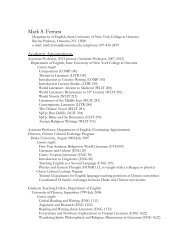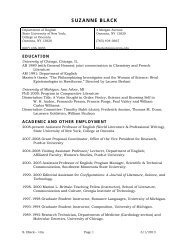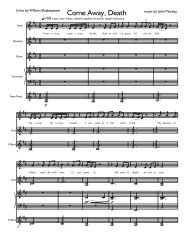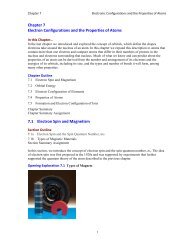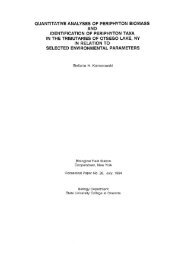Water Chestnut (Trapa natans L.) Infestation in the ... - SUNY Oneonta
Water Chestnut (Trapa natans L.) Infestation in the ... - SUNY Oneonta
Water Chestnut (Trapa natans L.) Infestation in the ... - SUNY Oneonta
You also want an ePaper? Increase the reach of your titles
YUMPU automatically turns print PDFs into web optimized ePapers that Google loves.
fruits have long been consumed by humans and were sold by street vendors <strong>in</strong> western<br />
New York State from about 1925 to 1935. Canned <strong>Trapa</strong> fruits are sold <strong>in</strong> gourmet food<br />
shops and plants are still be<strong>in</strong>g cultivated for <strong>the</strong> edible nuts, however, most t<strong>in</strong>ned<br />
“water chestnuts” are <strong>in</strong> fact Cyprus esculentus (Les and Merhoff 1999). The <strong>Trapa</strong> fruit<br />
conta<strong>in</strong>s much starch and fat, and are a staple food <strong>in</strong> eastern Asia, Malaysia, and India<br />
(Heywood 1993).<br />
Effects on Ecosystem Processes<br />
<strong>Trapa</strong> <strong>natans</strong> and many o<strong>the</strong>r <strong>in</strong>vasive aquatics can <strong>in</strong>vade an area and severely<br />
alter an ecosystem. Wetlands, <strong>in</strong> particular, seem especially vulnerable to <strong>the</strong>se <strong>in</strong>vasions<br />
because <strong>the</strong>y are landscape s<strong>in</strong>ks, which accumulate debris, sediments, water and<br />
nutrients. Even though less than 6% of <strong>the</strong> earth’s land mass is wetland, 24% of <strong>the</strong><br />
world’s most <strong>in</strong>vasive plants are wetland species (Zedler and Kercher 2004). Wetland<br />
<strong>in</strong>vaders contrast with many terrestrial <strong>in</strong>vaders <strong>in</strong> that: seeds are often dispersed by<br />
water, plants and plant parts can be dispersed by flotation, and aerenchyma protects<br />
below ground plant tissues from flood<strong>in</strong>g <strong>in</strong> anoxic soils and has <strong>the</strong> ability for rapid<br />
nutrient uptake, thus allow<strong>in</strong>g for rapid growth (Zedler and Kercher 2004).<br />
In wetlands, non-<strong>in</strong>digenous species abundance is associated with road density,<br />
suggest<strong>in</strong>g that landscape position <strong>in</strong>teracts with dispersal pathways and disturbances to<br />
help plant establishment. Wetlands fed by surface water from agricultural and urbanized<br />
watersheds usually have many <strong>in</strong>vasive species. Wetlands that are not fed primarily by<br />
surface water have small watersheds, depend<strong>in</strong>g on o<strong>the</strong>r sources for <strong>the</strong>ir water supply<br />
like ra<strong>in</strong>fall or groundwater. These wetlands are usually species rich and relatively free of<br />
<strong>in</strong>vasive plants (Zedler and Kercher 2004).<br />
There are many characteristics of wetlands that provide an area for opportunistic<br />
plant <strong>in</strong>vaders such as: runoff, nutrient cycles, sediment composition, open stand<strong>in</strong>g<br />
water, human made structures, and sal<strong>in</strong>ity cycles. The characteristics that benefit an<br />
<strong>in</strong>vasion by <strong>Trapa</strong> <strong>natans</strong> will be discussed <strong>in</strong> more detail. Floodwaters accumulate <strong>in</strong><br />
wetlands, and anoxia becomes a cumbersome challenge for most species, except those<br />
that are flood tolerant. These species usually possess aerenchyma tissues. Plants with<br />
aerenchyma can also achieve high plant biomass, potentially grow<strong>in</strong>g very rapidly. <strong>Trapa</strong><br />
stems conta<strong>in</strong> aerenchyamtous tissues and <strong>the</strong>refore have that advantage. <strong>Trapa</strong> also has a<br />
great advantage <strong>in</strong> that its adventitious roots positively respond to changes <strong>in</strong> water depth<br />
and nutrient availability. Dense, float<strong>in</strong>g mats of rhizomes provide ano<strong>the</strong>r advantage for<br />
reasons discussed earlier (Orth and Moore 2004).<br />
Wetlands have shown to be significantly altered by plant <strong>in</strong>vaders. Many <strong>in</strong>vasive<br />
plants are unwanted because of <strong>the</strong> effects <strong>the</strong>y have on habitat structure. Species that<br />
alter <strong>the</strong> physical structure of a site have high potential for shift<strong>in</strong>g hydrological<br />
conditions and animal uses. Invasive plants are commonly understood to reduce both<br />
plant and animal diversity. (Zedler and Kercher 2004). Invasive plants that differ from<br />
native species <strong>in</strong> biomass and productivity, tissue chemistry, plant morphology, or<br />
phenology, can alter soil nutrient dynamics. Invasive species can affect food webs <strong>in</strong><br />
multiple ways, by alter<strong>in</strong>g <strong>the</strong> quantity and quality of food, by chang<strong>in</strong>g food supply, or<br />
by chang<strong>in</strong>g susceptibility to predators (Zedler and Kercher 2004).<br />
9



